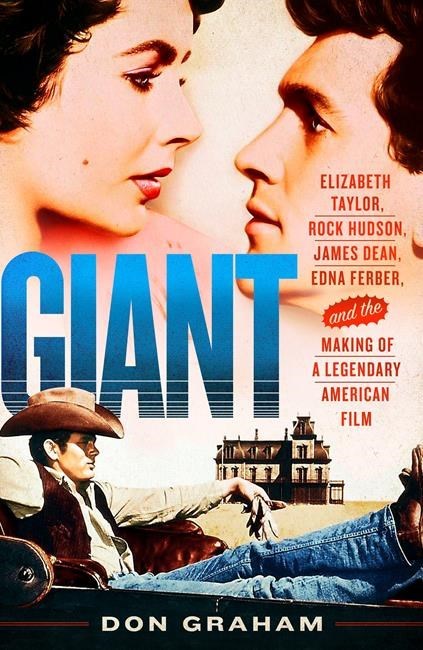Douglass K. Daniel

This cover image released by St. Martin's Press shows "Giant: Elizabeth Taylor, Rock Hudson, James Dean, Edna Ferber, and the Making of a Legendary American Film," by Don Graham. (St. Martin's Press via AP)
April 09, 2018 - 8:32 AM
"Giant: Elizabeth Taylor, Rock Hudson, James Dean, Edna Ferber, and the Making of a Legendary American Film" (St. Martin's Press), by Don Graham
No matter what you think of the 1956 epic "Giant" — some love it as an all-time favourite, some find it overblown — Don Graham's book is an entertaining case study for anyone who wants to understand how Hollywood lived and breathed in the mid-1950s. His behind-the-scenes story provides as much drama as director George Stevens' sometimes lumbering movie about a handsome but hidebound cattle baron who brings his East Coast bride to a not-so-little house on the prairie.
In the book "Giant," writer Edna Ferber did what she had done so well in the bestsellers "Show Boat" and "Cimarron," presenting a barbed social history of a place and its people riven by family clashes and conflicting business interests (cattle versus oil) and stained by racism (white mistreatment of Latinos). Real-life Texans waited and worried to see how their state would fare in a movie version.
All that tension appealed to Stevens, then 50, whose documentary work in Nazi death camps during World War II brought a new maturity to his movie career. His long standing as a top director ("Gunga Din" and "Shane," among others) helped fend off Warner Bros. boss Jack Warner as the "Giant" budget nearly doubled to accommodate Stevens' desire for location shooting and plenty of footage — he took a year just to edit the seemingly endless amounts of film.
Shooting in little Marfa, Texas, instead of Southern California gave British-born Elizabeth Taylor and Midwesterners Rock Hudson and James Dean a stronger sense of their characters and the land that impacted their lives. Among the delights of Graham's making-of book are their fish-out-of-water experiences and the everlasting influence of "Giant" on Marfa itself. Stevens welcomed all visitors to his set, especially the local folks, who got an eyeful of celebrities and moviemaking.
Stevens had to corral wildly different personalities on his set, and each gets an insightful mini-biography in Graham's pages. Taylor, 23, and just starting to take acting seriously after nearly two dozen films, reunited happily with Stevens, her director for "A Place in the Sun" a few years earlier. She was with husband No. 2, actor Michael Wilding, and a mother of two young boys, yet skipped off to West Texas for weeks of location shooting. Before the movie came out she was separated from Wilding and six months from marrying again.
Her two co-stars competed for her attention, in Hudson's case a deep friendship rather than a movie-set romance. Just 29, he was fearful his career upswing would be ruined if word got out that he was gay. After completing his role in "Giant" he married his agent's secretary. The movie brought Hudson new respect, plus an Oscar nomination and top ranking at the box office. He and his wife soon separated and he returned to his secret life.
Dean liked to be mothered by Taylor and most other women in his orbit, having lost his own mother when he was a child. He might have had the most to gain from "Giant," only his third film after numerous television appearances. At 24, he was the quintessential bad boy, showing up late, driving fast, turning rude to colleagues and guests without warning — in general, a glutton for attention and a bur under his director's saddle. Yet Stevens discovered what directors Elia Kazan ("East of Eden") and Nicholas Ray ("Rebel Without a Cause") already knew: Dean was a pain, but you couldn't take your eyes off him when he was on the screen.
The male co-stars disliked each other. By some accounts Hudson thought Dean was crude and unprofessional while Dean dismissed Hudson as a Hollywood actor not up to Actors Studio standards — and too fey for Dean's tastes, which spanned the sexual universe from Mars to Venus. "Giant" was still in production when Dean fatally crashed his Porsche sports car on a California highway in September 1955. He would compete with Hudson posthumously for Oscar honours, but the only Academy Award from the movie's 10 nominations would go to its director.
Warner's investment paid off financially when "Giant" brought in $12 million at the box office, trailing only mega-hits "The Ten Commandments" and "Around the World in 80 Days" in a year when the average ticket cost 60 cents. Whether it holds up artistically is arguable, but the film is a fine example of the postwar epic drama. Graham makes the most of the toil and trouble behind "Giant," bringing to life an era of filmmaking that's gone with the West Texas wind.
___
Douglass K. Daniel is the author of "Anne Bancroft: A Life" (University Press of Kentucky).
News from © The Associated Press, 2018